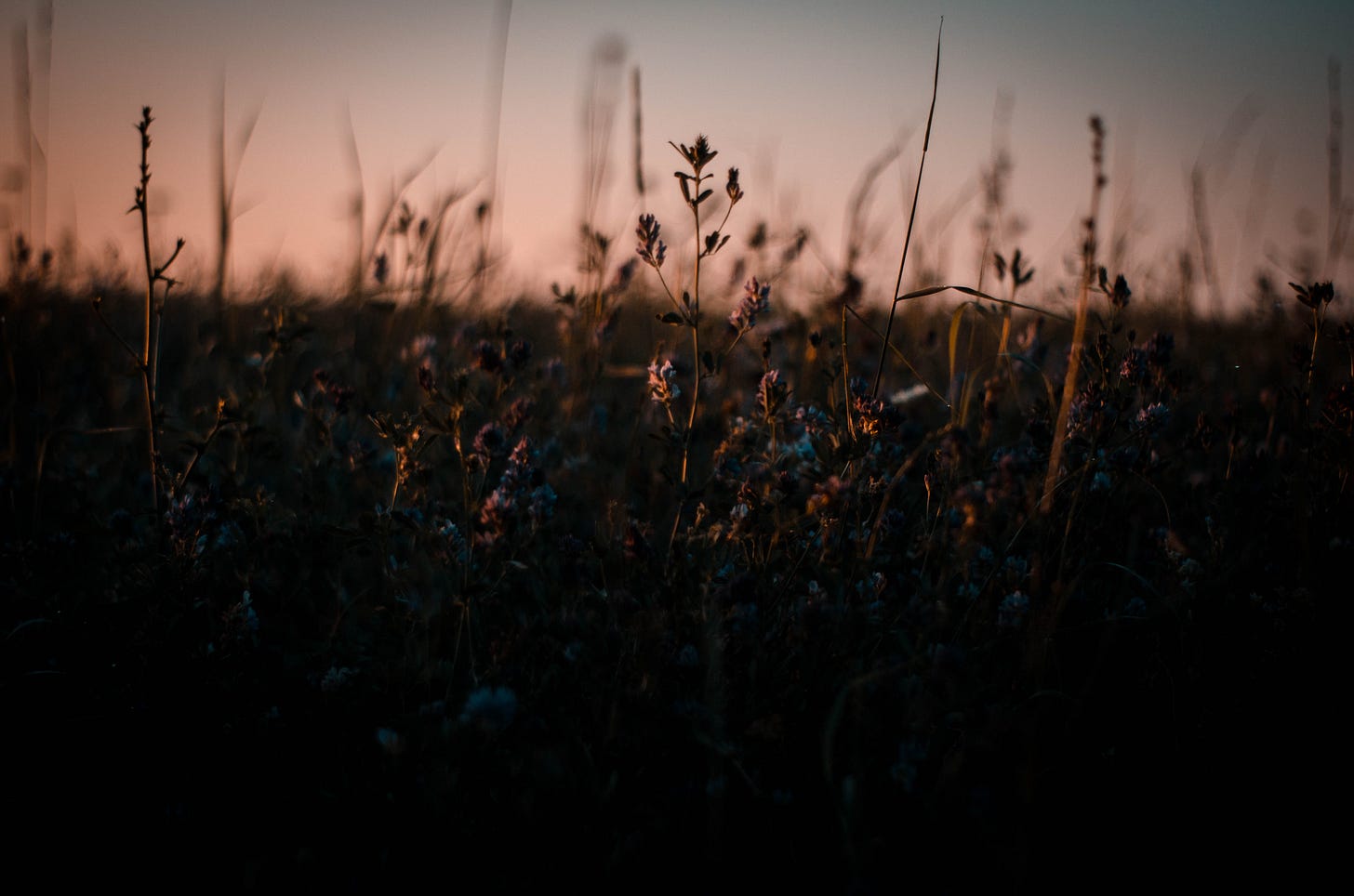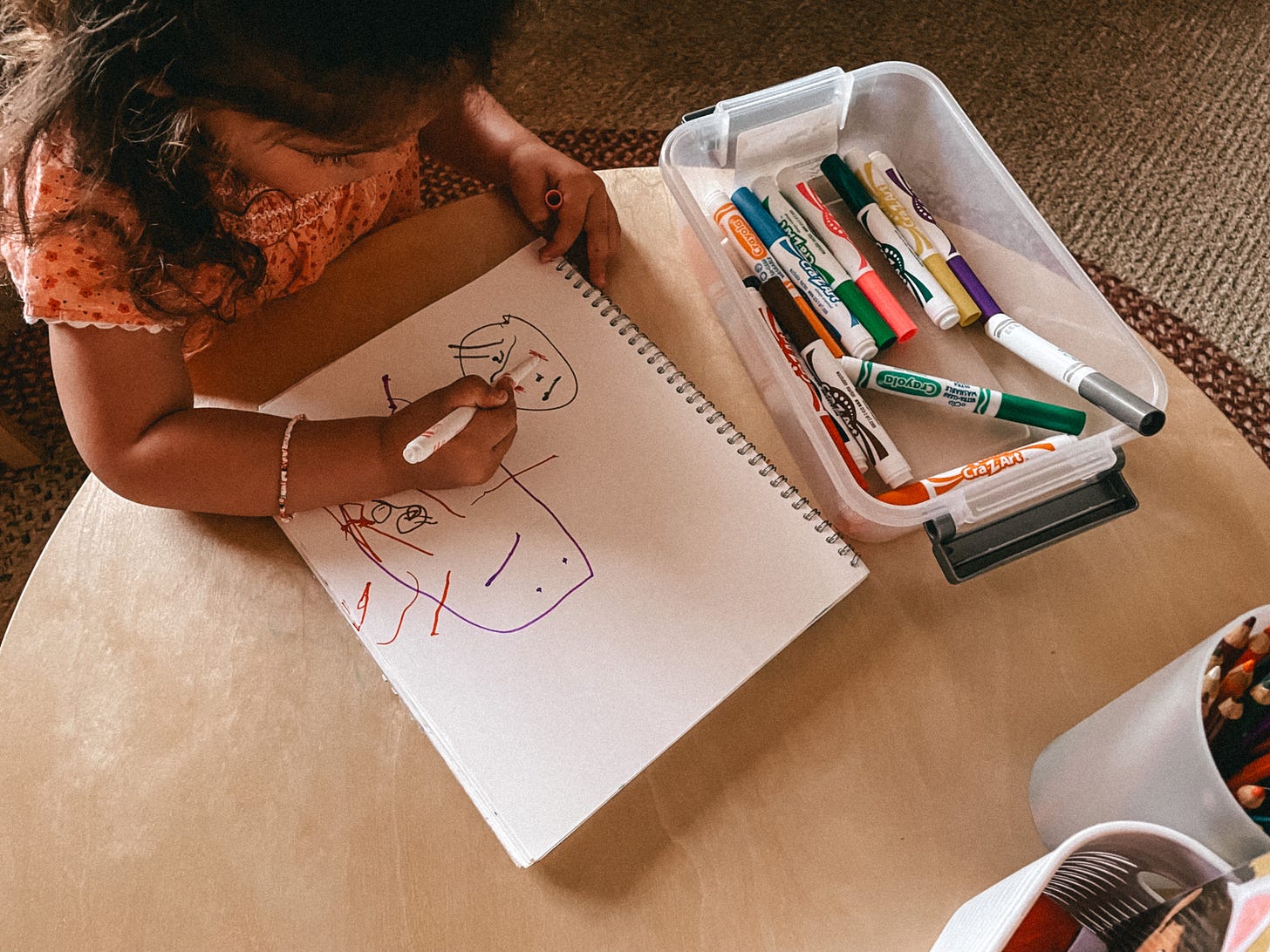Like the Wildflowers
I want to create a life like the wildflowers grow—in both sunshine and in darkness.

By virtue, we aren’t supposed to like weeds. The name ‘weed’ itself indicates something intrusive and unwelcome, where great efforts are taken to eradicate it from gardens and lawns. But in this particular video with which the Facebook algorithm gods graced me, Sir Anthony David Attenborough enlightens viewers about the tiny miracles of wildflowers.1 He strolls the busy streets of London’s Piccadilly Circus, one of the more hostile environments for plant life in the city, pointing out that weeds, or—as he calls them—"pioneers", can take advantage of even the harshest environments.
“And yet, even here,” he tells the camera as time-lapse footage shows a wildflower bursting through a crack in the sidewalk, “plants will find a way.” Its stem emerges from the dusty fracture in the path and cranes towards the sky as crowds of people bustle around it.
Attenborough points us to the ivy-leaved toadflax, a wild plant often found growing out of stone walls and pavements in England. Initially, as the ivy begins to flower, it is phototropic—meaning it grows toward the light. But once it has successfully pollinated, the plant changes course and instead begins to seek out darkness. In the shadowy nooks and crannies of old walls and sidewalks, the ivy begins to gain a solid foothold.
Spending time in the dark allows the plant to venture further than it ever would if it stayed only in the light.
One of my favorite views this time of year is out my kitchen window. The north side of our home overlooks a vacant lot that remains empty year after year due to an unresolved sibling property dispute (or so the neighborhood gossip goes). A vacant lot doesn’t sound like the most romantic view to have out your kitchen window, much less one of your favorite views. But this time of year—when springtime erupts across this region of the world—the dusty lot is covered in waves of multicolored wildflowers.
In the morning, as I wash oatmeal out of bowls and wipe down the sink, from my window I can spot one flower in particular rising among the overgrowth of grass and wheat—a yellow salsify. For several afternoons in a row, my daughter and I would walk out our front door, post-nap, and go directly to the flower. Its petals were closed each time we’d check on it. We’d eagerly wait for the salsify to finally open and bloom, but it never seemed to.
After some research (God bless gardening bloggers), I learned, along with their official name, that the salsify only opens early in the morning and remains open for just a few hours. Once the day is well underway, it closes its petals until the next morning. The rhythmic opening-and-closing of the wildflower has become a curious way for my three-year-old to begin telling time—or at least the difference between morning and not-morning.
My daughter has recently learned how to draw smiley faces. Since mastering this she leaves smiley faces sprinkled over every paper surface. “Eye, eye, smile.” She walks herself through the steps. The smile part is still tricky, the smooth curve of a grin complicated. It usually comes out more like a shaky horizontal zig-zag. Sometimes she recognizes this and declares the face as mad or surprised. More often than not, she is proud of her hard work, running to me with a construction paper full of colorful smiles.
Toddler years are enchanting on so many levels, but adventuring outside daily with one of them reminds me that children innately know magic when they see it. Time stops when a ladybug is spotted clinging to a giant blade of grass, when a perfect rock is found to throw in puddles, and when the burst of wildflowers wraps around our feet.
My daughter will ask to record a video of each of these things, my camera roll now filled with precious, shaky footage of blurry grass and the tops of her shoes, and the red smoosh of her pointer finger. These little ten-second videos show how she sees her world and the tiny magic that captures her attention.
And that’s also how I’ve learned so much about the wildlife that grows just outside our window. We’ve lived in this neighborhood for five years, but only now have I begun to get curious, thanks to a toddler who wants to know the names of everything around here.
So now we know that arugula and chamomile grow wild in empty lots; it’s common for people here to forage for them. We once watched an entire family hunched over along a roadway median with plastic bags in their hands, plucking the weeds to bring back home. The heads of the chamomile would likely have been brewed for tea and the arugula set on the table next to meat dishes at dinner.
I’m all too aware that writing about plants is not the coolest thing to write about. But something is fascinating about how these wildflowers can make their homes in vacant lots, garbage dumps, urban meadows, and ancient stone walls.
It’s like an act of defiance: creating beautiful life in harsh conditions. It’s done in such a quiet and unobtrusive way that it all feels a little bit miraculous.
I keep thinking about the ivy that intentionally grows toward darkness. And the salsify out my window that only opens its yellow petals for a few hours each morning.
Can I create a life here while standing in the middle of darkness? I watch my daughter create more squiggly-lined smiley faces across the paper.
Can I create a life here while still holding onto the hope of the sun (even if the sun never comes)?2 She stands back to proudly show off her work. “He’s nervous!” she declares, pointing to the crooked line of his mouth. She uncaps a different colored marker and keeps going.
Instead of straining my eyes from staring at the horizon that holds an ever-shifting endpoint, I force myself to turn my head to the side, to notice what is blooming on my left and sprouting on my right, to see the sky unfolding above me and the little miracles thriving at my feet.
Fixating on times that have not yet arrived only forces my eyes away from the ordinary glories in front of me. And if I let myself get sucked into the future, I am missing what’s happening here and now. After all, as the saying goes, how we spend our days is how we spend our lives.3
But doing so is hard. My hands are caked in dirt. Mud and sweat are swiped across my forehead. It takes so much work, tears, prayers, and screams just to burst my head above the hostile ground and notice the beauty around me.
But I want to create a life like the wildflowers grow—in both sunshine and in darkness.
I want to create even when conditions are harsh—just a little bit, only as much as I can handle—trusting that somewhere deep down, green is growing, waiting to burst forth.
I want to create even while holding onto hope of a future beyond here.
I want to create, believing that doing so does not diminish the hardships we are enduring now.
I want to create like my daughter does: with shaky hands and squiggly lines, still learning and still so proud.
I want to create while in the darkness.
I want to create while waiting.
I want to create anyway.
This post is part of a blog hop with Exhale—an online community of women pursuing creativity alongside motherhood, led by the writing team behind Coffee + Crumbs. Click here to view the next post in the series "Create Anyway".
This post is also inspired by Ashlee Gadd’s book, Create Anyway: The Joy of Pursuing Creativity in the Margins of Motherhood—an encouragement and timely reminder that motherhood and creativity can and should coexist.
I really love the message on this mixed media collage.
Taken from Annie Dillard’s book, A Writing Life. The full quote reads: “How we spend our days is, of course, how we spend our lives. What we do with this hour, and that one, is what we are doing. A schedule defends from chaos and whim. It is a net for catching days. It is a scaffolding on which a worker can stand and labor with both hands at sections of time. A schedule is a mock-up of reason and order—willed, faked, and so brought into being; it is a peace and a haven set into the wreck of time; it is a lifeboat on which you find yourself, decades later, still living.”







Beautiful! And that image of the flower seeking out darkness is going to stay with me awhile!
Stunning. Holding these words close.